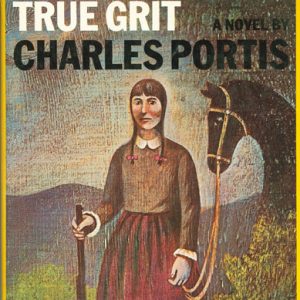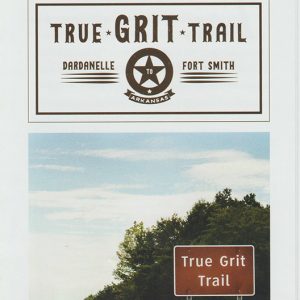calsfoundation@cals.org
True Grit
“Here is what happened.” With those simple words, Mattie Ross of Dardanelle (Yell County) begins her reminiscence of the time she avenged her father’s murder with the help of a one-eyed deputy marshal and a dandy Texas Ranger. Set in western Arkansas and the Indian Territory of the 1870s, the novel True Grit, written by Arkansan Charles Portis, mixes this unlikely trio of personalities into a bestselling western adventure. Published in 1968, True Grit was adapted into a movie and released the following year. The movie garnered veteran actor John Wayne the only Oscar of his career for his portrayal of Deputy Marshal Rooster Cogburn. In 2010, a second film adaptation of the novel, written and directed by Joel and Ethan Coen and starring Jeff Bridges, was released.
The novel True Grit is narrated by Mattie, an elderly unmarried woman, who recounts her teenage adventure: “I was just fourteen years of age when a coward going by the name of Tom Chaney shot my father down in Fort Smith, Arkansas, and robbed him of his life and his horse and $150.” Seeking revenge and justice, Mattie travels to Fort Smith (Sebastian County) and learns that Chaney has crossed into Indian Territory (now Oklahoma). The territory is under U.S. marshal jurisdiction, so Mattie decides to entice a lawman with a reward to hunt down her father’s killer. She chooses Cogburn, considered the “meanest” marshal but a man she believes has “true grit.”
Mattie also meets LaBoeuf, a Texas Ranger holding a warrant for Chaney’s arrest in another murder. She views LaBoeuf as arrogant and smug, but the three form a reluctant team. The men hope to rid themselves of Mattie as they enter the territory, but she proves to be tenacious and accompanies them despite their attempts to lose her. Ironically, it is Mattie who unexpectedly stumbles upon Chaney. She shoots and wounds him with her father’s gun, but Chaney carries her off to his hiding place. In the climax, LaBoeuf and Cogburn rush to her aid as she dangles in a snake pit. Mattie’s faith in Cogburn is well placed—against formidable odds, he saves her life. Years later, Mattie hears that Cogburn has fallen on hard times and is performing in a traveling “Wild West” show. She decides to meet him, but he dies before she arrives. Mattie arranges for Cogburn’s body to be returned to Dardanelle and buried in her family plot.
True Grit’s fame rests on its skillful blend of quirky characters, Southern regionalism, and western-style adventure. Mattie’s narrative tone is naïve, prim, proper, and full of Old Testament resonances. She speaks with such “implacable stoniness” that one never doubts her mental and physical fortitude. Pair her with a one-eyed, fat, middle-aged, hard-drinking, good/bad man, plus a Texan who thinks too highly of himself, and the contrasts produce a wellspring of conflict and humor. Yet despite these differences, the characters discover a common “grit” in each other that becomes a basis for respect and personal growth.
The novel also highlights elements of the Arkansas frontier: decent folks farming and living on the edge of civilization, strong religious institutions, Judge Parker–type justice, outlaws, and a lively commercial center straddling civilization and wilderness. Portis describes this environment with a liberal use of Southern idioms that creates what one critic described as “a yarn with swagger, color and song.”
The final ingredient in the novel is western-style action with its emphasis on violent confrontations and dangerous situations. Cogburn’s horseback charge with his guns blasting against outlaws and Mattie’s precarious dangling in a rattlesnake-infested pit are examples of the many tense scenes the characters navigate. Although the story ends on a bittersweet note, the lessons of strength and courage have entered our culture. “True grit” has become a common expression to describe a particular type of persevering fortitude.
True Grit was first published and serialized in a much shorter form in the Saturday Evening Post. The current book version was released shortly afterward and was a commercial and critical success. Some reviewers found the story hard to categorize because they felt the novel contained elements of a fictional memoir, a western, and a historical novel. Many reviewers felt Mattie’s character was an equal to Mark Twain’s venerated Huckleberry Finn. The novel was labeled a “classic” and a book that “contributes meaningfully to American humor.” True Grit has remained almost continuously in print since its release. Starting in 1999, Overlook Press reissued all of Portis’s novels including True Grit.
After the book was published, Paramount Pictures quickly acquired the rights to True Grit as a vehicle to showcase John Wayne, who would portray Rooster Cogburn. Marguerite Roberts adapted the novel for the screen, and Henry Hathaway directed the movie. Although Mattie is the central character in the book, Cogburn’s character was accentuated in the film because of Wayne’s cinematic stature. Arkansas native Glen Campbell played LaBoeuf and also sang the title song, which was nominated for an Academy Award. Kim Darby portrayed Mattie. The dialogue and plot points remain true to the novel except for the movie’s ending, which has LaBoeuf dying, Mattie’s arm healing instead of being amputated, and Cogburn returning to Dardanelle in the final scene to visit Mattie. Portis wrote the last scene for the movie to create a more uplifting ending.
Arkansans viewing the film were probably surprised to see snow-capped mountains in Mattie’s hometown in Yell County. Although Hal Wallis, the producer, considered shooting the movie in Arkansas, he eventually decided to use the Rocky Mountains in Colorado as the backdrop for the film.
The movie was so popular that a sequel, Rooster Cogburn (…and the Lady), was released in 1975. John Wayne returned to the role of Deputy Marshal Cogburn, and Katharine Hepburn starred as the new damsel in distress. In 1978, a made-for-TV movie, True Grit: A Further Adventure, continued the saga of Rooster and Mattie. Warren Oates and Lisa Pelikan starred in the TV version. Fans and critics did not warm to the change in actors or the plot, and no further sequels were made.
In 2010, Paramount Pictures released a second movie adaptation of True Grit, written and directed by the Academy Award–winning Coen brothers. This version starred Jeff Bridges as Rooster Cogburn, Matt Damon as LaBoeuf, Josh Brolin as Tom Chaney, and Hailee Steinfield as Mattie Ross in her first motion picture role. The film was shot in New Mexico and Texas. Unlike the 1969 adaptation, the 2010 film more closely adhered to the novel in plot and theme, including the ending in which Mattie Ross, her arm having been amputated as a result of snakebite, ventures to meet Cogburn some twenty-five years after their adventure together, only to find that he had died before her arrival. Critics largely praised the performances and story, comparing it favorably with its 1969 predecessor. The film was nominated for ten Academy Awards but failed to win any.
In 2019, the Arkansas General Assembly established the True Grit Trail to highlight those places in western Arkansas that play a role in the novel.
For additional information:
Garfield, Brian. “Song and Swagger of the Old West.” Saturday Review, June 29, 1968, p. 25.
Matthews, Kristan L. “True Grit: A Radical Tale.” Journal of American Culture 41 (December 2018): 370–384.
Park, Ed. “Like Cormac McCarthy, But Funny.” The Believer 1 (March 2003). Online at https://believermag.com/like-cormac-mccarthy-but-funny/ (accessed February 17, 2020).
Portis, Charles. True Grit. New York: Simon and Schuster, 1968.
Shuman, R. Baird. “Portis’ ‘True Grit’: Adventure Story or ‘Entwicklungsroman’?” The English Journal 59 (March 1970): 367–370.
Tartt, Donna. Introduction to True Grit. London, England: Bloomsbury Publishing Ltd., 2004.
Talley, Caleb. “True Grit and the Man Who Wrote It.” AY Magazine, April 2018, pp. 32–35. Online at https://www.aymag.com/true-grit-man-wrote/ (accessed February 17, 2020).
“True Grit (1969).” Internet Movie Database. http://www.imdb.com/title/tt0065126/ (accessed February 17, 2020).
“True Grit (2010).” Internet Movie Database. http://www.imdb.com/title/tt1403865/ (accessed February 17, 2020).
Turner, Ralph Lamar. “‘Why Do You Think I am Paying You if Not to Have My Way?’ Genre Complications in the Free-Market Critiques of Fictional and Filmed Versions of True Grit.” Journal of Popular Culture 48 (April 2015): 355–370.
Gina Kokes
Little Rock, Arkansas
 Arts, Culture, and Entertainment
Arts, Culture, and Entertainment Literature and Authors
Literature and Authors Movies
Movies Charles Portis and John Wayne
Charles Portis and John Wayne  True Grit by Charles Portis
True Grit by Charles Portis  True Grit
True Grit  True Grit Trail
True Grit Trail 



Comments
No comments on this entry yet.